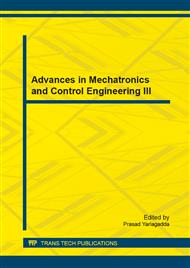p.295
p.299
p.305
p.309
p.313
p.318
p.325
p.333
p.338
Diagnosis and Estimation of Sensor Bias in Dynamic Systems Using Adaptive Techniques
Abstract:
The estimation and detection of sensor bias fault in a dynamic system is discussed. The development of more general methodology for diagnosing sensor bias faults in a dynamic system which depends on the state of the system is established. The non linearity in the system nominal model is assumed to be the function of input and output only, this note used the adaptive technique of model based system and Kaczmarz’s Projection algorithm. An Observer is designed to generate residual of the system which indicates the presence of fault and initiates to estimate unknown sensor bias in the presence of model uncertainties. The tank level system is considered for simulative example is presented to illustrate the methodology. The robustness, sensitivity and stability properties of the dynamic system were analyzed.
Info:
Periodical:
Pages:
313-317
Citation:
Online since:
October 2014
Authors:
Price:
Сopyright:
© 2014 Trans Tech Publications Ltd. All Rights Reserved
Share:
Citation:


